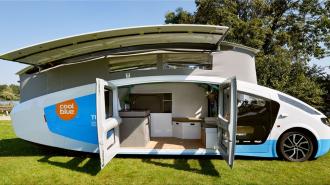A solar-powered motorhome, shaped like a huge elongated teardrop, silently rolled into Madrid on Friday as part of a month-long journey from the Netherlands to southern Spain to highlight more sustainable modes of transport.
Engineering students at the Technical University of Eindhoven in the Netherlands created the blue and white vehicle, named Stella Vita – Latin for “star” and “life” – to inspire car makers and politicians to accelerate the transition toward green energy.
Expansive solar panels on the roof and on lateral wings that unfold when the vehicle stops allow the self-sustaining house on wheels, or SHOW, to travel up to 740 km (460 miles) on a sunny day, while the battery can also power a fridge, coffee maker and laptop in the two-person cabin.
“Of course when there is no sun we have a small problem but we designed the car to charge it on the electrical grid as well,” said Lotte Van Dasler, a 23-year old biomedical engineering student who has spent the last year working on the project.
She is particularly pleased with the vehicle’s combined information and entertainment system, which provides real-time data on energy consumption and production, forcing the driver to carefully consider the trade-off between different uses.
“Everyone knows what a metre looks like… but if I ask how much is one kilowatt hour, do you know?
“It creates more energy awareness… You can make the choice between do I want to make my breakfast, or drive a few kilometres further.”
With no power steering or assisted braking, the SHOW is tricky to manoeuvre around tight spaces but can cruise comfortably down the highway at 120 kilometres an hour.
“It’s like a normal car with normal pedals and brakes,” explained Tjin Ter Horst, 21, another of the car’s designers. “It’s nothing special except for the fact that it’s 7.2 metres (23.62 ft) long, so you should take that into account.”
After two weeks on the road, the group expects to arrive in Spain’s southernmost point of Tarifa on Oct. 15, before taking the car to design shows and exhibitions around Europe.
Republished with permission of the World Economic Forum under a Creative Commons license. Read the original article.






